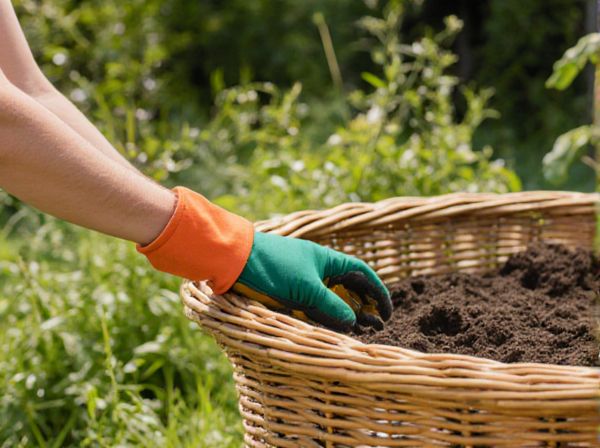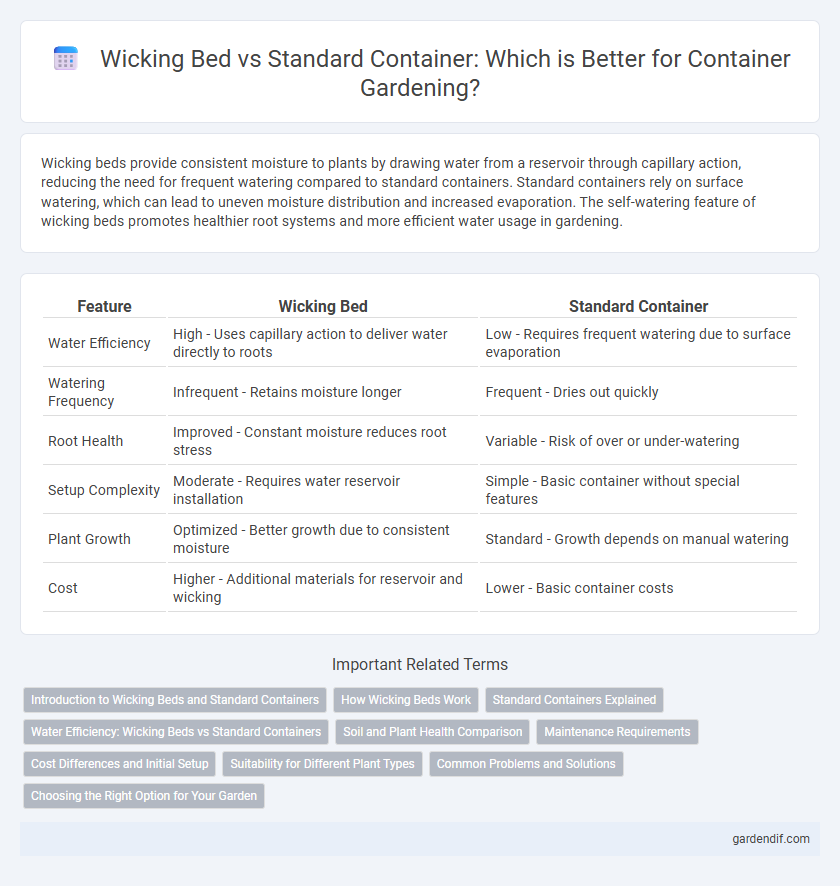
Wicking bed vs Standard container Illustration
Wicking beds provide consistent moisture to plants by drawing water from a reservoir through capillary action, reducing the need for frequent watering compared to standard containers. Standard containers rely on surface watering, which can lead to uneven moisture distribution and increased evaporation. The self-watering feature of wicking beds promotes healthier root systems and more efficient water usage in gardening.
Table of Comparison
| Feature | Wicking Bed | Standard Container |
|---|---|---|
| Water Efficiency | High - Uses capillary action to deliver water directly to roots | Low - Requires frequent watering due to surface evaporation |
| Watering Frequency | Infrequent - Retains moisture longer | Frequent - Dries out quickly |
| Root Health | Improved - Constant moisture reduces root stress | Variable - Risk of over or under-watering |
| Setup Complexity | Moderate - Requires water reservoir installation | Simple - Basic container without special features |
| Plant Growth | Optimized - Better growth due to consistent moisture | Standard - Growth depends on manual watering |
| Cost | Higher - Additional materials for reservoir and wicking | Lower - Basic container costs |
Introduction to Wicking Beds and Standard Containers
Wicking beds utilize a self-watering system with a water reservoir beneath the soil, enabling plants to draw moisture upward through capillary action, significantly reducing water wastage compared to standard containers. Standard containers rely on traditional top watering methods, which can lead to uneven moisture distribution and increased evaporation. The design of wicking beds promotes consistent root hydration and supports sustainable gardening practices by minimizing the frequency of watering.
How Wicking Beds Work
Wicking beds operate by using a water reservoir beneath the soil that supplies moisture directly to plant roots through capillary action, minimizing water waste and promoting consistent hydration. Unlike standard containers that rely on surface watering, wicking beds allow plants to access water from below, supporting healthier root systems and reducing evaporation. This self-watering mechanism enhances water efficiency, making wicking beds ideal for drought-prone areas or environments with limited water availability.
Standard Containers Explained
Standard containers provide a versatile and widely used option for gardening, offering durability and ease of use for various plant types. These containers allow for controlled soil conditions and efficient water management, though they may require more frequent watering compared to wicking beds. Made from materials like plastic, fabric, or metal, standard containers support root growth while facilitating drainage and oxygen flow.
Water Efficiency: Wicking Beds vs Standard Containers
Wicking beds maximize water efficiency by using a self-watering system that delivers moisture directly to plant roots, reducing evaporation and runoff compared to standard containers. Standard containers typically require more frequent watering, leading to higher water consumption and increased risk of soil drying out. This water-saving feature makes wicking beds ideal for drought-prone areas or water-conscious gardeners.
Soil and Plant Health Comparison
Wicking beds use a self-watering system that maintains consistent soil moisture, promoting healthier root growth and reducing plant stress compared to standard containers that rely on surface watering, which can lead to uneven moisture distribution and root drying. The soil in wicking beds stays aerated and nutrient-rich due to the slow, upward water movement, enhancing microbial activity and nutrient uptake, whereas standard containers often suffer from waterlogging or drying out, damaging soil structure. Plants in wicking beds typically demonstrate increased vigor and resilience, benefiting from stable hydration and improved soil conditions, unlike those in standard containers where fluctuating moisture levels can stunt growth.
Maintenance Requirements
Wicking beds require less frequent watering compared to standard containers due to their self-watering system, which reduces maintenance efforts. Standard containers demand regular monitoring and watering to prevent soil drying and plant stress, increasing time and resource investment. The design of wicking beds also minimizes nutrient leaching, resulting in lower fertilization needs over time.
Cost Differences and Initial Setup
Wicking beds generally have a higher initial setup cost compared to standard containers due to their integrated water reservoir and specialized materials that promote self-watering. Standard containers require less investment upfront but often need more frequent watering and maintenance, which can increase long-term costs. The choice between the two depends on budget constraints and willingness to invest in an efficient, low-maintenance irrigation system upfront.
Suitability for Different Plant Types
Wicking beds provide consistent moisture levels ideal for water-sensitive plants such as tomatoes, herbs, and leafy greens, promoting healthy growth with less frequent watering. Standard containers suit drought-tolerant plants like cacti, succulents, and Mediterranean herbs, offering better drainage to prevent root rot. Choosing the right container depends on the plant's water requirements and root system preferences for optimal growth.
Common Problems and Solutions
Wicking beds often face common problems such as poor drainage and salt buildup, which can be mitigated by incorporating a well-designed reservoir and regular flushing of the soil. Standard containers struggle with inconsistent moisture levels and root rot, solved by using high-quality potting mix with good aeration and ensuring proper drainage holes. Both systems benefit from monitoring soil moisture and adjusting watering routines to prevent under or overwatering issues.
Choosing the Right Option for Your Garden
Wicking beds offer a self-watering system that reduces water usage by drawing moisture from below, making them ideal for drought-prone areas or busy gardeners. Standard containers provide more flexibility in plant choices and are generally easier to move and customize with different soil mixes and drainage options. Selecting between a wicking bed and a standard container depends on factors like water efficiency, garden space, and maintenance preferences.
Wicking bed vs Standard container Infographic

 gardendif.com
gardendif.com